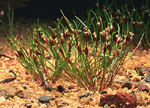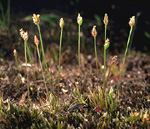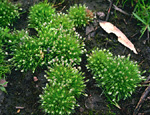 |
This small family is mainly Australian, with Centrolepis extending
to New Zealand and Malesia, and Gaimardia to southern South America.
They are found in seasonally moist, sandy soil in open habitats almost
throughout Australia except the most arid deserts and the high alps.
Characteristic features of the family Centrolepidaceae in Australia include: - small (often tiny), tufted sedge-like herbs with linear, sheathing leaves
- flowers without a perianth, unisexual or apparently bisexual, several together enclosed by bracts at the ends of unbranched, stiff, leafless scapes
- male flowers comprising a single stamen and female flowers a single carpel (but often several flowers grouped into a false 'flower' with 1-2 stamens and several carpels)
- fruit a tiny, thin-walled, 1-seeded follicle
Description
Annual or perennial terrestrial herbs. Perennating by rhizomes. Stem internodes terete or rarely strongly flattened. Internal secretions not obvious. Plants glabrous or with simple or dendritic, non-glandular, uniseriate hairs. Leaves alternate and spiral, or distichous, cauline, or all or most basal, sessile. Stipule-like lobes absent. Lamina simple, symmetric, filiform, acicular, subulate, linear or oblong; margins entire, ±flat, involute or incurved; one-veined, or the venation rarely parallel, with the midrib inconspicuous, and tertiary venation not reticulate; surfaces not punctate; herbaceous or leathery. Leaf ligule rarely present. Male and female flowers occurring on the same plant. Inflorescences terminal, consisting of capitula or spikes. Bracts present. Bracteoles present or absent. Pollination by wind. Flowers odourless; sessile. Floral disc absent; nectaries absent. Perianth absent. Fertile stamens 1 (–2), free of or at least partly fused with the ovary or style, distinct from each other, all ±equal. Anthers dorsifixed, versatile, opening outwards by short or longitudinal slits; 1-celled. Ovary superior and sessile. Carpels 1–30, free or fused by styles into pseudanthia; ovary with 1 locule. Style terminal, single and branched above or from the base. Ovule 1, stalked or sessile; placentation apical. Fruit sometimes formed from several flowers (composite), dry, dehiscent or indehiscent, a follicle or utricle; the perianth on the maturing fruit deciduous. Disseminule macro-surface featureless, or with straight or hooked hairs; micro-surface ±smooth or colliculate, cream or brown, dull. Seeds 1–30 per fruit. Aril absent. Cotyledons 1. Embryo round or shapeless.
(Note: this description has been generated from the coded data compiled for the key. Any errors in the key data will be reflected in the descriptions.)
A treatment of the family Centrolepidaceae has not yet been published
in the Flora of Australia. It will appear in Volume 40.
Australian genera of Centrolepidaceae (as recognised for the Flora of Australia)
Aphelia
Brizula
Centrolepis
Gaimardia

|
  |

Centrolepis polygyna (flowering plants)
Photo: D.Hardin © D.Hardin

Centrolepis polygyna (flowering plants)
Photo: M.Fagg © M.Fagg

Centrolepis strigosa (flowering plants)
Photo: D.Hardin © D.Hardin

Centrolepis strigosa (flowering plants)
Photo: S.Jacobs © S.Jacobs
|
 |
|